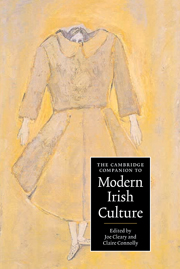Book contents
- Frontmatter
- 1 Introduction: Ireland and modernity
- Part I Cultural politics
- Part II Cultural practices and cultural forms
- 9 Modernism and the Irish revival
- 10 Poetry in Ireland
- 11 Irish sport
- 12 Projecting the nation: cinema and culture
- 13 Folk culture
- 14 Irish prose fiction
- 15 Irish music
- 16 Modern architecture and national identity in Ireland
- 17 The visual arts in Ireland
- 18 Irish theatre
- Index
17 - The visual arts in Ireland
from Part II - Cultural practices and cultural forms
Published online by Cambridge University Press: 28 May 2006
- Frontmatter
- 1 Introduction: Ireland and modernity
- Part I Cultural politics
- Part II Cultural practices and cultural forms
- 9 Modernism and the Irish revival
- 10 Poetry in Ireland
- 11 Irish sport
- 12 Projecting the nation: cinema and culture
- 13 Folk culture
- 14 Irish prose fiction
- 15 Irish music
- 16 Modern architecture and national identity in Ireland
- 17 The visual arts in Ireland
- 18 Irish theatre
- Index
Summary
Introduction
The history of the visual arts in Ireland in the nineteenth and twentieth centuries is the ongoing story of the relationship between a metropolitan culture (London) and a smaller, less economically sustainable environment (Dublin). The production of art is an expensive activity. Although all cultural media need patronage and financial assistance, the visual arts have the added burden of needing materials, be it oils and canvases or marble blocks or the latest innovations in information technology, so as to begin the process of visual communication. Finally, it needs forms of display to make it all accessible to an audience, be it private or public. For much of the period under discussion, 1800-2000, Ireland was very often not in a position to greatly assist its visual artists. In many ways an account of the visual arts in relation to Ireland in the modern period is a story of talent exported to London and in more recent times to other European cities and also to New York. In the nineteenth century London was the metropolis of empire while in the twentieth century it and other international locations have become convenient sites for artistic training, exhibition and sales. That economic dependency is vital to an understanding of the progress of the visual arts over the last two hundred years.
The nineteenth century
One of the key facts in discussing pre-twentieth-century Irish art is the dominant position of the British School. No native-born artists have had the cultural effect that John Constable, J. M. W. Turner or David Wilkie had in their native England or Scotland, while at the same time most prominent Irish artists of the period – from James Barry who died in 1806 to Sir John Lavery who died in 1941 – are still staunchly included in most reference books as British artists. The problem lies with the export of talent to London and the economic impossibility of making a living in Dublin or Ireland in general.
- Type
- Chapter
- Information
- The Cambridge Companion to Modern Irish Culture , pp. 304 - 321Publisher: Cambridge University PressPrint publication year: 2005
- 1
- Cited by



